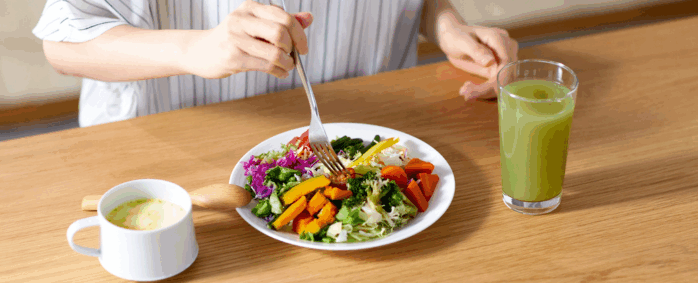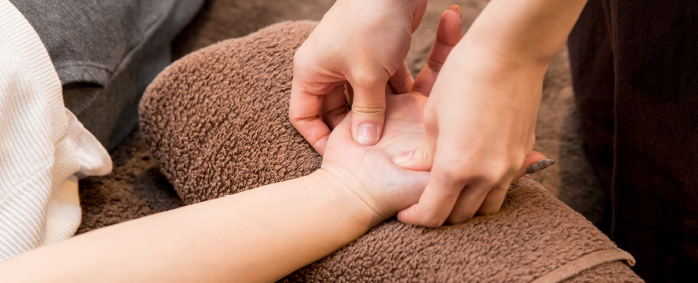From Stiff to Supple – Natural ways to Improve Posture and Mobility
- Blog
- From Stiff to Supple – Natural ways to Improve Posture and Mobility
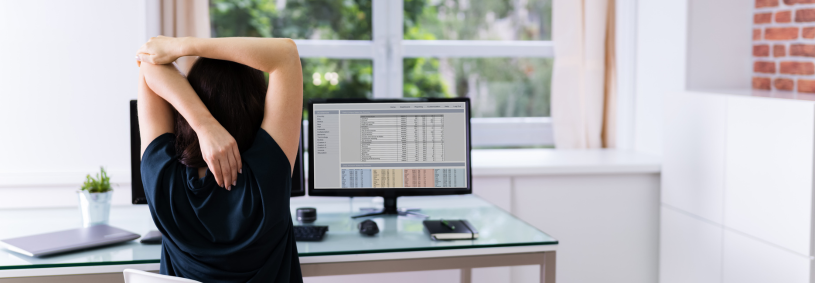
WHY IS POSTURE AND MOBILITY IMPORTANT FOR OVERALL HEALTH AND DAILY WELLBEING?
A simple definition if you like: Postural Alignment is for structural integrity. Structural Integrity is to minimise wear and dysfunction.
I use the term “Fun Fact” to share interesting and often surprising anatomical facts and statistics. Like this one for the position of the head and neck in relation to what’s ideal for postural alignment.
For every 2.5cm the head sits forward of ideal, its the same as placing another head on your neck and shoulders! Another way of saying it is “For every 2.5 cm your head moves forward, the pressure on your neck doubles!”(1)
So why do we crane our head forward? Simply put – its due to our anatomy! Our eyes are at the front, so we focus forward and we don’t realise how out of alignment we get. Not to mention gravity pulling us towards the ground… we get real good at being chair shaped.
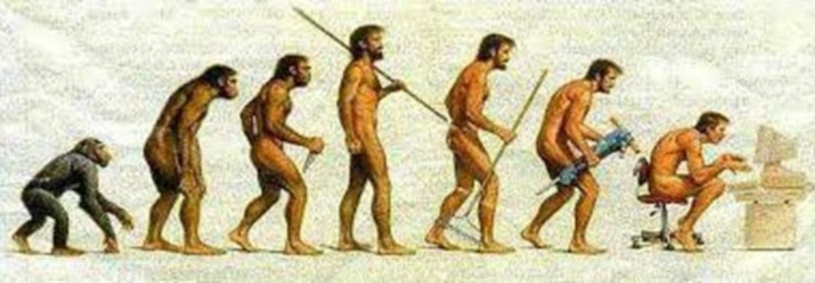
In relation to Posture, neurologically we need “ideal” and I say ideal as its impossible to define ‘normal’ or even correct, let alone perfect. We are best served to aim for ideal posture no matter what we are doing. Ideal posture in all our daily actions, not just when we are standing up straight.
Ideal or optimal alignment is necessary for the entire body to function effortlessly.
The communication lines from fascia to nerves all have a place and a job, they can’t be compressed, or stressed etc and still do their job. Effortless, graceful motion is the goal.
Grace is where mobility comes in to address the second part of question one.
Mobility – the way I describe mobility and the effects of a joint that moves freely, is, its like taking the handbrake off the soft tissues for ease of movement. When the joints are free to move (as they are designed to), they are effortless to move and the muscles can do their work not only effectively, but, efficiently as well.
Like a wheel that needs aligning on the car, you fix that wheel so you don’t have to replace your tyres. We aim to avoid replacing our joints, even surgeons nowadays delay that very thing for as long as possible. With evidence rising that many (common) orthopaedic surgeries are no better than conservative actions. (2) Which means, to be proactive and (pun intended) – move!
We also know – movement is life!
Just as we need touch (3) and human connection/interaction… we need movement.
“The more you move the better your longevity, or healthy lifespan. To meet your longevity needs you should complete 25 minutes per day or moderate exercise…” (4) Along with the following, incase you need little more motivation! “Movement is a fundamental aspect of life. It affects everything from circulation to digestion to metabolism to immunity.” (5)
Who said movement is life?
Moshe Feldenkrais said, ‘movement is life.’ And ‘Awareness of our responses and our possibilities allow us to respond appropriately to changes in our inner and outer environment.” (6)
On a deeper level…
“Without movement, there truly is no life, and we understand this on a purely biological level. Blood cells that don’t move can’t transport oxygen, hearts that don’t move can’t pump blood and spines that don’t move can’t create movement for daily living or for the stimulation of the joint-brain pathways required for proper brain and body communication.” (7)
“Show me someone who does not move well, and I will show you someone with declining health.” Park East Chiro USA.
What you can do about all this is found at the end of this article. But first let’s review a little fact or fiction!
FACT OR FICTION: Good Posture = perfectly straight spine all the time.
Fact but a relative Fact! (So hold your reactions)
As Joseph Pilates is renown for saying: “You are only as young as your spine is flexible.” (8) And from the many movement modalities I’ve trained in (including Pilates Floor Method with two different training providers) this rings very true.
Yet – “perfectly straight” I’d change to perfectly aligned.
You can be bending and flexing the spine or side bending it (which is ‘not straight’) but you can be aligned and move with awareness which is safe and effective.
I started with FACT – as there is a very good movement program that trains ‘straight’ whilst hinging at the hips… which is how we are designed to move. The vertebral column is such a magical design. It has great range, takes immense loads and if we apply this functional movement pattern as much as possible, we can avoid the typical LBP (Lower Back Pain) and issues from wear and strain.
That said, we want our spine (and whole body) to be as mobile and flexible as possible. We want to be able to move in all directions with ease and ultimately disperse loads effectively. This is otherwise known as ‘movement variability’.(10)
How can we move optimally? INITIAL STEPS
- Think about your body… and actually be grateful for it. Our greatest wealth is our health and independence. I see many in my clinic and coaching with issues that could have been prevented with a little knowledge and a lot more of a body focus day to day.
- Start with one joint mobility in the AM and one stretch in the PM. Prepare your body to serve all day with ‘juicing up’ those joints, and then thank the body for its service by ‘elongating in the evening’.
- Get out of your shoes, get onto grass or sand a few times a week. Barefoot at home is great BUT it is unchallenging to the feet and your nervous system. We want the unstable, ‘wobbly’ movement that these natural surfaces provide.
- Be mindful of your vocational requirements. We move repetitiously and habitually. The majority of our daily actions are unconscious which means we live on ‘auto-pilot’ most of the time. (11 & 12)
COMMON CAUSES OF STIFFNESS & POOR POSTURE.
Can poor posture cause muscle stiffness? Yes! And vice versa – stiffness can add to poor posture. A cyclic spiral of adaptation and moving further away from ideal.
“At first, when you have poor posture, the muscles in your neck, shoulders, and chest become overactive and strained. That causes the muscles in the front of your chest (major and minor pectoralis) to tighten and become shorter. Over time, the surrounding counter muscles are underused causing them to become weaker.” (12)
So what does that mean for the everyday person, getting through their technology driven, seated day?
It means, the more you move and the more you move consciously can un-do and counterbalance all the sitting that is required of the 2025 lifestyle.
I’m victim of it too! I’ve NEVER sat as much as I’ve had to in the past three to four years. And “I don’t like it!” My day is mapped to account for all the sitting I ‘have to do’ and how I’m going to counterbalance….all that sitting.
Unfortunately for us humans, we are innately lazy. Our nervous system is wired to conserve energy and we have immediate access to way too many calories and there is no longer a need to ‘conserve’ your energy. (13) We have unceremoniously reversed that and we need to expend our energy!
But I digress a little there. To complete the digression….
Do go read the article in reference 13.
Now, to the practical and tangible aspects of this article.
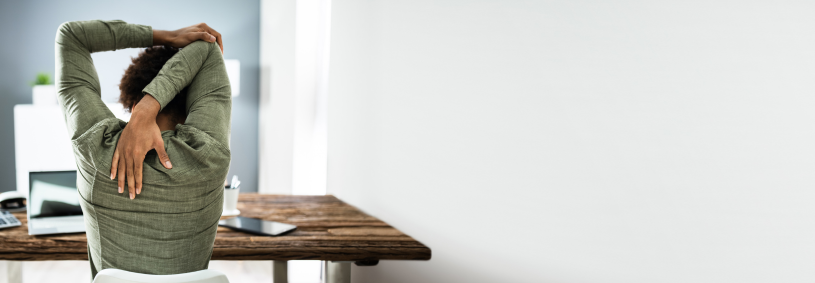
INTRODUCE A FEW PRACTICAL EXERCISES THAT YOU CAN TRY AT HOME
The key is consistency – it doesn’t take much to create change in the body MAINTAINING those changes is where the work is.
Every body is as unique as each individual on this planet. Some analogies that come up in coaching and Posture Plus classes – “Blue Tack v’s Plasticine”. Which means, you need to prepare and coax the body to move. Force leads to injury. Have a conscious conversation with your body, and, your body will do what you tell it.(14)
Extension is the necessary counterbalance to modern seated living. Extensibility is key! Remember the effects of gravity? Release the flexors to enable the extensors to do their job with ease, not battle us upright.
Also pliability, to be elastic and graceful as apposed too stiff and effortful or forceful.
Mantras I live and coach by:
- Mobility in the morning! Otherwise known to my participants and patients as: “breakfast for the body” We do the mobility joint work in the AM and ‘Juice up the Joints’.
- Demo ankle mobility [do these as you brush your teeth]
- Break up your day if you are professional desk sitter! Forearm and hand release on chair
- Stretch and ‘elongate in the evening’. This is to release, de-compress and allow the body to rest at its optimal relaxed state. Helps wind down from the day and prepare the body for the night.
The more relaxed the body the better the sleep you can enjoy.
Shoulder release (great at the desk whilst on the phone)


Standing hip release with glute activation (as above great at the desk!)
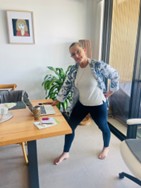
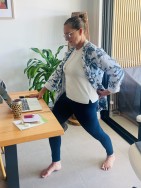
Getting off your seat to release hands and forearms
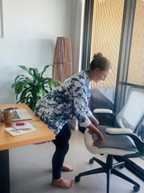

WHY MOVEMENT FIRST? One word Fascia.
“Fascia can be defined as a mechano-metabolic structure containing connective tissue that permeates all organs, muscles, bones and nerve fibres in the human body, forming and supporting them, and providing their continuity.” (15)
Like the first ‘chair’ image above, we get good at what we do the most and the body (fascia) adjusts itself via ‘creep’(16) to form us into what we do the most. Better expressed here from the Cleveland Clinic…
“Fascia is one of the richest sensory organs in our body, embedded in nerve endings and mechanoreceptors (muscle spindles, Ruffini and Pacini corpuscles, Golgi endings and free nerve endings). Fascia plays a major role in the perception of posture and movement affecting our proprioception and coordination. Whenever we change our posture or move in any way fascial tissues’ mechanoreceptors deform and activate, sending afferent information into the spinal cord and brain. These messages are interpreted by our central nervous system (CNS), then efferent information is relayed to our muscles.” (16)
We need to move to balance all structures and tissues, which enables us to become structurally homeostatic! Balanced, aligned, functioning optimally. We need to move to un-do the hours of minimal and repetitious movement the majority of us ‘have’ to do for our modern living. Think about your typical day…
How often do you do the movements suggested above in the exercise section of this article?
Final words, you get good at what you do the most. Make moving through ALL ranges of motion your daily habit and maintain a harmonious and fluidly functional body.
REFERENCES:
- https://360physiorevesby.com.au/forward-head-posture-what-it-is-how-to-fix-it/
- https://www.sydney.edu.au/medicine-health/news-and-events/news/2022/04/12/orthopaedic-surgeries-doing-more-harm-than-good.html
- https://thecarltoddclinic.com/insights/the-benefits-of-physical-touch-for-mental-health/#:~:text=The human need for touch,to social and emotional development.
- https://harrisonhealthcare.ca/live-longer-simple-movement/
- https://hr.wustl.edu/the-value-of-movement/#:~:text=Movement is a fundamental aspect,emotions, learning, and relationships.
- https://www.feldenkraissf.com/movement#:~:text=Moshe Feldenkrais said, ‘Movement is,our inner and outer environment.
- https://www.parkeastchiro.com/blog/169106-movement-is-life
- https://www.bookey.app/quote-author/joseph-pilates
- https://pubmed.ncbi.nlm.nih.gov/21802756/
- https://web.colby.edu/cogblog/2020/11/24/moving-from-autopilot-towards-mindfulness/
- https://www.psychologytoday.com/au/blog/the-well-being-toolkit/202401/5-ways-to-step-out-of-autopilot-and-into-your-life
- https://squareonehealth.com/understand-how-poor-posture-weakens-and-damages-your-muscles/#:~:text=At first, when you have,causing them to become weaker.
- https://medium.com/@lisahoelzer/the-motivational-triad-47c645c47805
- https://medicine.washu.edu/news/mind-body-connection-is-built-into-brain-study-suggests/#:~:text=The study shows that parts,say the practitioners of mindfulness.
- https://www.physio-pedia.com/Fascia#:~:text=At the beginning of loading, is forced from the
tissue.
- https://my.clevelandclinic.org/health/body/23251-fascia#:~:text=It’s a continuous layer
of,made up of multiple layers.
More about the author
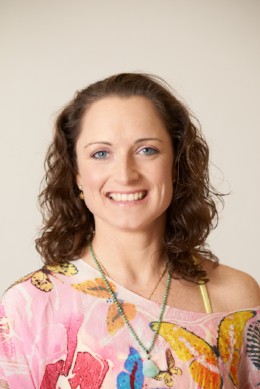
Donna Eddy
A committed and proactive healer
I deeply understand how debilitating pain can be. As a former movement coach and trainer, I turned to movement therapy to restore my health after suffering a serious back injury at 21.
Over the past 30 years, I’ve committed myself to learning and applying the best techniques for managing and recovering from pain, as well as addressing the deeper layers of life, including stress and unresolved emotional issues. I’ve immersed myself in the world of movement and therapy, becoming a registered acupuncturist with expertise in three acupuncture styles, a trained counselor and psychotherapist, a massage therapist, a stretch therapist, and a coach. Throughout my career, I’ve treated thousands of patients and educated clients of all ages, both privately and professionally.
I provide my clients with a comprehensive care package that includes personalized programming and detailed coaching. My approach is as varied as my training, and the results are consistently powerful and transformative. My life’s purpose is to teach, which I’ve done through teaching Diploma-level Anatomy & Massage at TAFE and to international students. My lifelong passion is to inspire movement and empower those who have suffered from pain or injury.
I’m here to teach, heal, counsel, and inspire. I currently run extended training open to Remedial Massage Therapists, to become providers of Posture Plus. Other programs for the public include: soul-nourishing immersions like ZenYin & Salubrious Sunrises, Life Medicine and Movement101 workshops. As well as, Mind-Body corporate programs like UNwind Wednesday & Free Feet Friday.
If you’re ready to take the next step toward feeling better, connect with me to discover how I can support you or your team. Choose to be the exception… age with vitality and live with Juvenescence.
https://www.donnaeddy.com/purchase-posture-plus
https://www.facebook.com/1973de
https://www.linkedin.com/in/donna-eddy-a9824820/
https://www.instagram.com/donnaeddy_lifemedicine/

